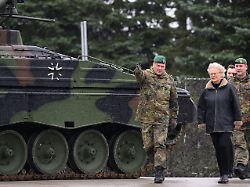Rheinmetall also supplies tanks
Lambrecht sends half of the “Marder” from the Bundeswehr camp
01/12/2023 5:29 p.m
During a visit, Defense Minister Lambrecht demonstrated the capabilities of the “Marder” to NATO’s Rapid Reaction Force. After all, the federal government wants to give Ukraine 40 copies for the fight against Russia. Another state must therefore first do without.
Defense Minister Christine Lambrecht sees the promised delivery of 40 armored personnel carriers to Ukraine and the planned training package on course. “The promise, as it was made, will also be made,” said the SPD politician in a barracks in Marienberg, Saxony. Lambrecht made it clear that the “Marder” did not come from the active population of the Bundeswehr.
According to information from the German Press Agency, the latest plans envisage that 20 of the tanks will come from Bundeswehr stocks and 20 more from the Rheinmetall armaments group. In return, Greece was asked to accept delays in the delivery of further “marders” for a certain period of time. In addition to providing them, Germany had also promised to provide the Ukrainians with training on the weapon system.
Lambrecht visited German soldiers of the NATO Rapid Reaction Force (VJTF) in Marienberg. She found out about the performance of two Panzergrenadier companies, which are also equipped with the “Marder” infantry fighting vehicle and are part of the NATO spearhead on increased operational readiness. Lambrecht had stopped an obligation to use the more modern infantry fighting vehicle “Puma” due to technical defects.
“Important signal to NATO”
Now two companies of Panzergrenadierbataillon 371 with their “Marder” infantry fighting vehicles are taking over the task of the rapid reaction force. 400 soldiers and support forces are ready there. “That was a very important signal to NATO, to our allies. We stand by our commitments, even under such special conditions,” said Lambrecht.
In the Erzgebirge barracks, the Panzergrenadiers and the crews of the “Marder” infantry fighting vehicle showed their skills. “This is a very robust vehicle, very off-road, agile and can be used in almost any scenario. There is a long experience with this vehicle,” said a soldier. “It doesn’t really matter to us how we’re deployed because we’re ready to go.”
The MELLS anti-tank system, with which guided missiles can be fired from tanks or dismounted soldiers, was also demonstrated. “We have a hit probability of 95 percent, in 5 percent there can be a technical failure,” said one of the soldiers, none of whom wanted to be named. “The riflemen are trained in such a way that practically every shot is intended to destroy a main battle tank.”
The VJTF (Very High Readiness Joint Task Force) was set up during the first major Ukraine crisis after 2014 and has since been a central element of the deterrence strategy against Russia. It also serves to reassure the NATO partners on the alliance’s eastern flank. According to the Bundeswehr, the land component of the NATO spearhead includes around 11,500 soldiers from nine NATO countries. Among them are about 8,000 men and women from Germany who have to be ready to leave within two to seven days. According to the information, there are also other German forces, such as around 2,600 soldiers from the Air Force and up to 700 from the Navy.
